Western Sydney University: Health Variations 2 Assignment - Diabetes
VerifiedAdded on 2023/01/05
|7
|1766
|82
Homework Assignment
AI Summary
This assignment analyzes a case study of a 5-year-old patient, Sarah, diagnosed with type 1 diabetes. It delves into the physiological mechanisms of insulin, the use of Novo rapid, and the implications of hypoglycemia. The assignment addresses the appropriate insulin pen needle size and injection techniques for children, considering factors like needle length and injection angles. It also examines the importance of blood glucose monitoring, potential physical and emotional challenges faced by patients, and the influence of diet and physical activity. The solution references key guidelines and research to provide a comprehensive understanding of diabetes management, emphasizing the significance of proper care and support for children with this chronic illness.

Running head: HEALTH VARIATION
HEALTH VARIATION
Name of the student:
Name of the university:
Author note
HEALTH VARIATION
Name of the student:
Name of the university:
Author note
Paraphrase This Document
Need a fresh take? Get an instant paraphrase of this document with our AI Paraphraser
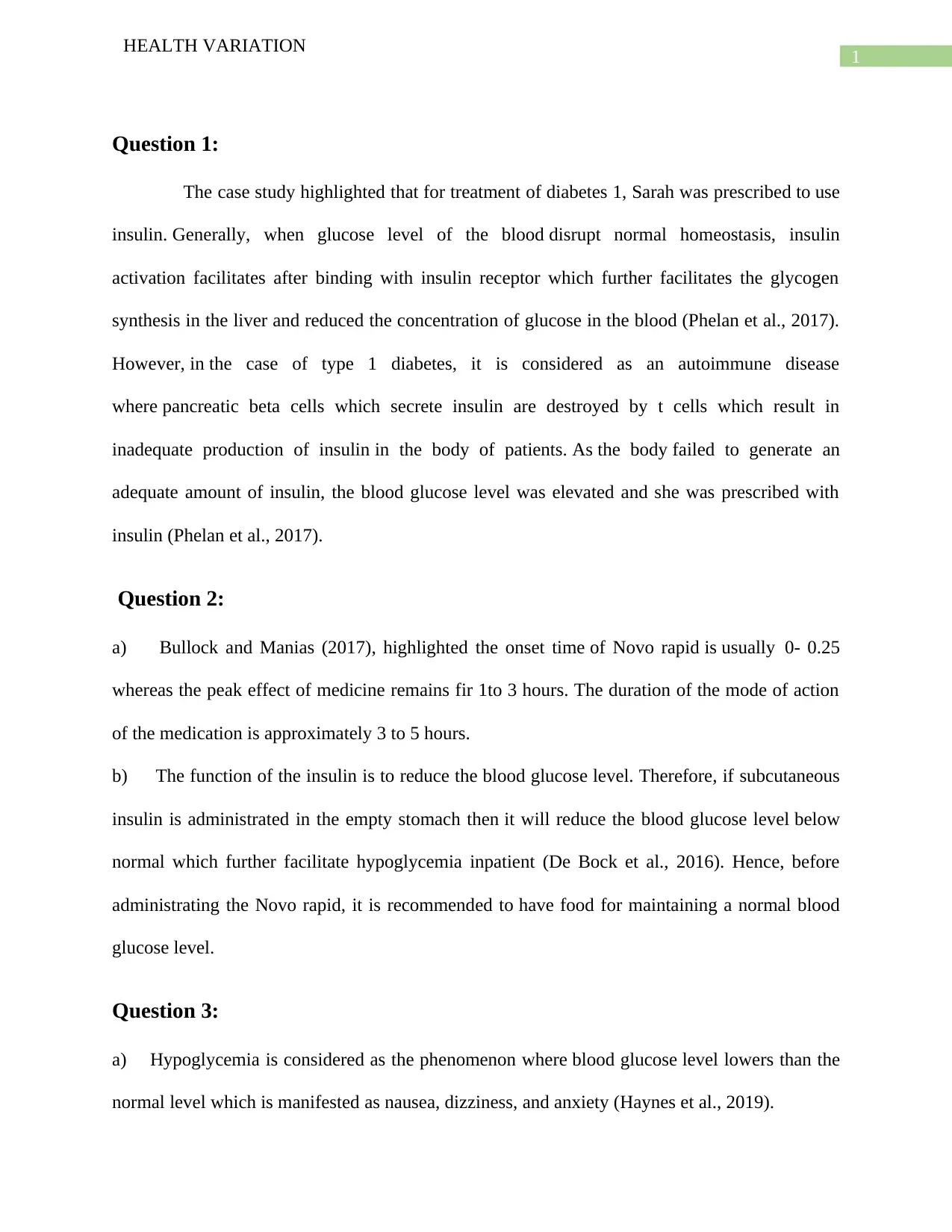
1
HEALTH VARIATION
Question 1:
The case study highlighted that for treatment of diabetes 1, Sarah was prescribed to use
insulin. Generally, when glucose level of the blood disrupt normal homeostasis, insulin
activation facilitates after binding with insulin receptor which further facilitates the glycogen
synthesis in the liver and reduced the concentration of glucose in the blood (Phelan et al., 2017).
However, in the case of type 1 diabetes, it is considered as an autoimmune disease
where pancreatic beta cells which secrete insulin are destroyed by t cells which result in
inadequate production of insulin in the body of patients. As the body failed to generate an
adequate amount of insulin, the blood glucose level was elevated and she was prescribed with
insulin (Phelan et al., 2017).
Question 2:
a) Bullock and Manias (2017), highlighted the onset time of Novo rapid is usually 0- 0.25
whereas the peak effect of medicine remains fir 1to 3 hours. The duration of the mode of action
of the medication is approximately 3 to 5 hours.
b) The function of the insulin is to reduce the blood glucose level. Therefore, if subcutaneous
insulin is administrated in the empty stomach then it will reduce the blood glucose level below
normal which further facilitate hypoglycemia inpatient (De Bock et al., 2016). Hence, before
administrating the Novo rapid, it is recommended to have food for maintaining a normal blood
glucose level.
Question 3:
a) Hypoglycemia is considered as the phenomenon where blood glucose level lowers than the
normal level which is manifested as nausea, dizziness, and anxiety (Haynes et al., 2019).
HEALTH VARIATION
Question 1:
The case study highlighted that for treatment of diabetes 1, Sarah was prescribed to use
insulin. Generally, when glucose level of the blood disrupt normal homeostasis, insulin
activation facilitates after binding with insulin receptor which further facilitates the glycogen
synthesis in the liver and reduced the concentration of glucose in the blood (Phelan et al., 2017).
However, in the case of type 1 diabetes, it is considered as an autoimmune disease
where pancreatic beta cells which secrete insulin are destroyed by t cells which result in
inadequate production of insulin in the body of patients. As the body failed to generate an
adequate amount of insulin, the blood glucose level was elevated and she was prescribed with
insulin (Phelan et al., 2017).
Question 2:
a) Bullock and Manias (2017), highlighted the onset time of Novo rapid is usually 0- 0.25
whereas the peak effect of medicine remains fir 1to 3 hours. The duration of the mode of action
of the medication is approximately 3 to 5 hours.
b) The function of the insulin is to reduce the blood glucose level. Therefore, if subcutaneous
insulin is administrated in the empty stomach then it will reduce the blood glucose level below
normal which further facilitate hypoglycemia inpatient (De Bock et al., 2016). Hence, before
administrating the Novo rapid, it is recommended to have food for maintaining a normal blood
glucose level.
Question 3:
a) Hypoglycemia is considered as the phenomenon where blood glucose level lowers than the
normal level which is manifested as nausea, dizziness, and anxiety (Haynes et al., 2019).
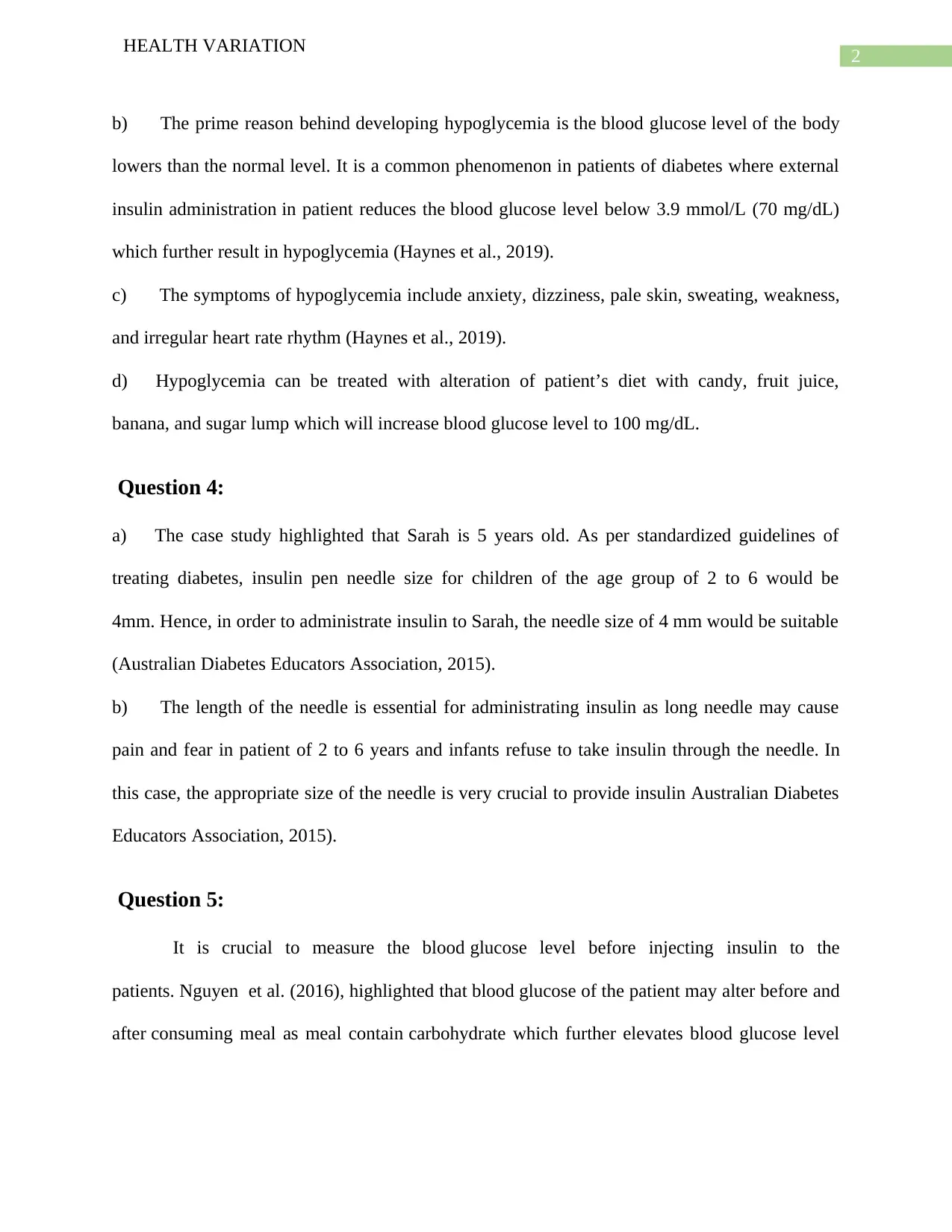
2
HEALTH VARIATION
b) The prime reason behind developing hypoglycemia is the blood glucose level of the body
lowers than the normal level. It is a common phenomenon in patients of diabetes where external
insulin administration in patient reduces the blood glucose level below 3.9 mmol/L (70 mg/dL)
which further result in hypoglycemia (Haynes et al., 2019).
c) The symptoms of hypoglycemia include anxiety, dizziness, pale skin, sweating, weakness,
and irregular heart rate rhythm (Haynes et al., 2019).
d) Hypoglycemia can be treated with alteration of patient’s diet with candy, fruit juice,
banana, and sugar lump which will increase blood glucose level to 100 mg/dL.
Question 4:
a) The case study highlighted that Sarah is 5 years old. As per standardized guidelines of
treating diabetes, insulin pen needle size for children of the age group of 2 to 6 would be
4mm. Hence, in order to administrate insulin to Sarah, the needle size of 4 mm would be suitable
(Australian Diabetes Educators Association, 2015).
b) The length of the needle is essential for administrating insulin as long needle may cause
pain and fear in patient of 2 to 6 years and infants refuse to take insulin through the needle. In
this case, the appropriate size of the needle is very crucial to provide insulin Australian Diabetes
Educators Association, 2015).
Question 5:
It is crucial to measure the blood glucose level before injecting insulin to the
patients. Nguyen et al. (2016), highlighted that blood glucose of the patient may alter before and
after consuming meal as meal contain carbohydrate which further elevates blood glucose level
HEALTH VARIATION
b) The prime reason behind developing hypoglycemia is the blood glucose level of the body
lowers than the normal level. It is a common phenomenon in patients of diabetes where external
insulin administration in patient reduces the blood glucose level below 3.9 mmol/L (70 mg/dL)
which further result in hypoglycemia (Haynes et al., 2019).
c) The symptoms of hypoglycemia include anxiety, dizziness, pale skin, sweating, weakness,
and irregular heart rate rhythm (Haynes et al., 2019).
d) Hypoglycemia can be treated with alteration of patient’s diet with candy, fruit juice,
banana, and sugar lump which will increase blood glucose level to 100 mg/dL.
Question 4:
a) The case study highlighted that Sarah is 5 years old. As per standardized guidelines of
treating diabetes, insulin pen needle size for children of the age group of 2 to 6 would be
4mm. Hence, in order to administrate insulin to Sarah, the needle size of 4 mm would be suitable
(Australian Diabetes Educators Association, 2015).
b) The length of the needle is essential for administrating insulin as long needle may cause
pain and fear in patient of 2 to 6 years and infants refuse to take insulin through the needle. In
this case, the appropriate size of the needle is very crucial to provide insulin Australian Diabetes
Educators Association, 2015).
Question 5:
It is crucial to measure the blood glucose level before injecting insulin to the
patients. Nguyen et al. (2016), highlighted that blood glucose of the patient may alter before and
after consuming meal as meal contain carbohydrate which further elevates blood glucose level
⊘ This is a preview!⊘
Do you want full access?
Subscribe today to unlock all pages.

Trusted by 1+ million students worldwide
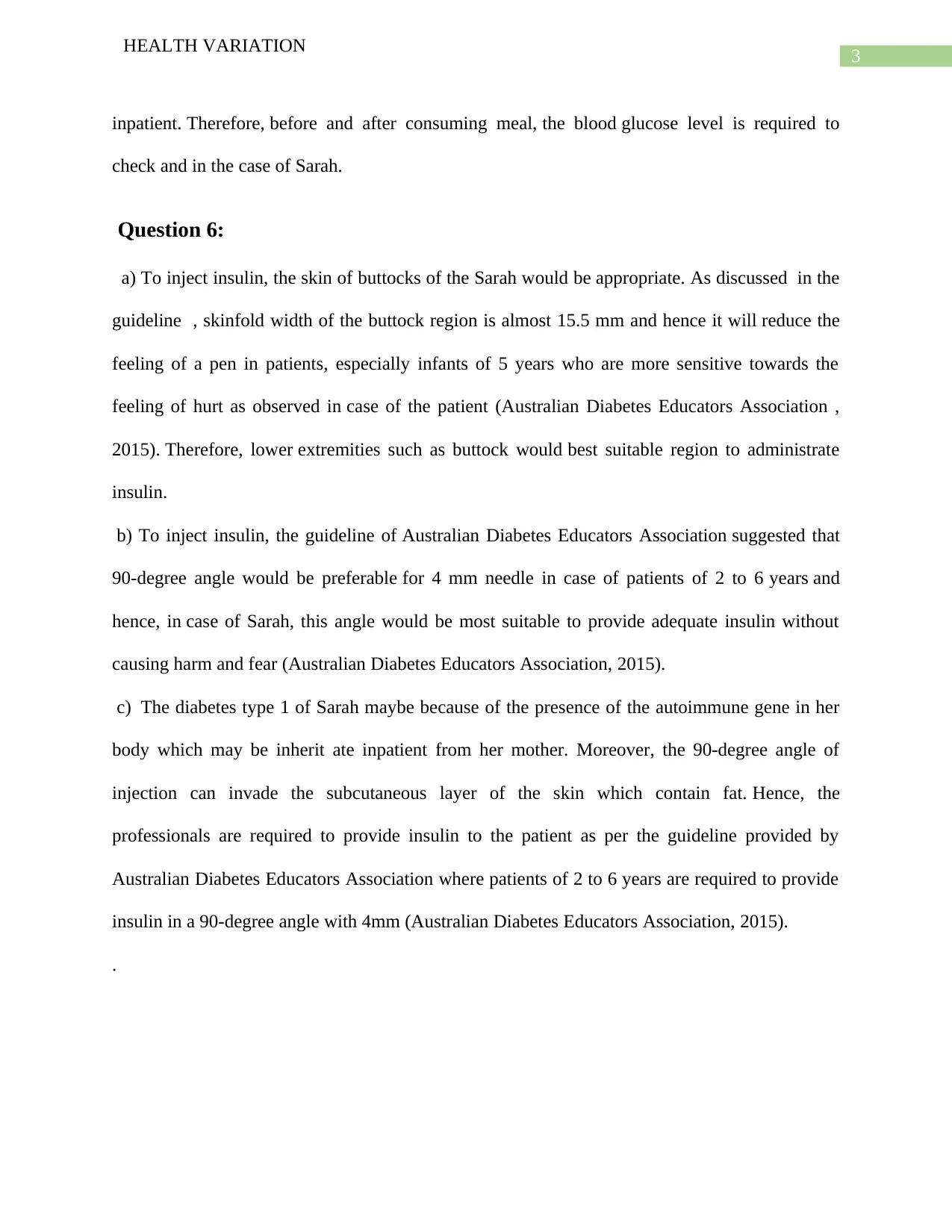
3
HEALTH VARIATION
inpatient. Therefore, before and after consuming meal, the blood glucose level is required to
check and in the case of Sarah.
Question 6:
a) To inject insulin, the skin of buttocks of the Sarah would be appropriate. As discussed in the
guideline , skinfold width of the buttock region is almost 15.5 mm and hence it will reduce the
feeling of a pen in patients, especially infants of 5 years who are more sensitive towards the
feeling of hurt as observed in case of the patient (Australian Diabetes Educators Association ,
2015). Therefore, lower extremities such as buttock would best suitable region to administrate
insulin.
b) To inject insulin, the guideline of Australian Diabetes Educators Association suggested that
90-degree angle would be preferable for 4 mm needle in case of patients of 2 to 6 years and
hence, in case of Sarah, this angle would be most suitable to provide adequate insulin without
causing harm and fear (Australian Diabetes Educators Association, 2015).
c) The diabetes type 1 of Sarah maybe because of the presence of the autoimmune gene in her
body which may be inherit ate inpatient from her mother. Moreover, the 90-degree angle of
injection can invade the subcutaneous layer of the skin which contain fat. Hence, the
professionals are required to provide insulin to the patient as per the guideline provided by
Australian Diabetes Educators Association where patients of 2 to 6 years are required to provide
insulin in a 90-degree angle with 4mm (Australian Diabetes Educators Association, 2015).
.
HEALTH VARIATION
inpatient. Therefore, before and after consuming meal, the blood glucose level is required to
check and in the case of Sarah.
Question 6:
a) To inject insulin, the skin of buttocks of the Sarah would be appropriate. As discussed in the
guideline , skinfold width of the buttock region is almost 15.5 mm and hence it will reduce the
feeling of a pen in patients, especially infants of 5 years who are more sensitive towards the
feeling of hurt as observed in case of the patient (Australian Diabetes Educators Association ,
2015). Therefore, lower extremities such as buttock would best suitable region to administrate
insulin.
b) To inject insulin, the guideline of Australian Diabetes Educators Association suggested that
90-degree angle would be preferable for 4 mm needle in case of patients of 2 to 6 years and
hence, in case of Sarah, this angle would be most suitable to provide adequate insulin without
causing harm and fear (Australian Diabetes Educators Association, 2015).
c) The diabetes type 1 of Sarah maybe because of the presence of the autoimmune gene in her
body which may be inherit ate inpatient from her mother. Moreover, the 90-degree angle of
injection can invade the subcutaneous layer of the skin which contain fat. Hence, the
professionals are required to provide insulin to the patient as per the guideline provided by
Australian Diabetes Educators Association where patients of 2 to 6 years are required to provide
insulin in a 90-degree angle with 4mm (Australian Diabetes Educators Association, 2015).
.
Paraphrase This Document
Need a fresh take? Get an instant paraphrase of this document with our AI Paraphraser
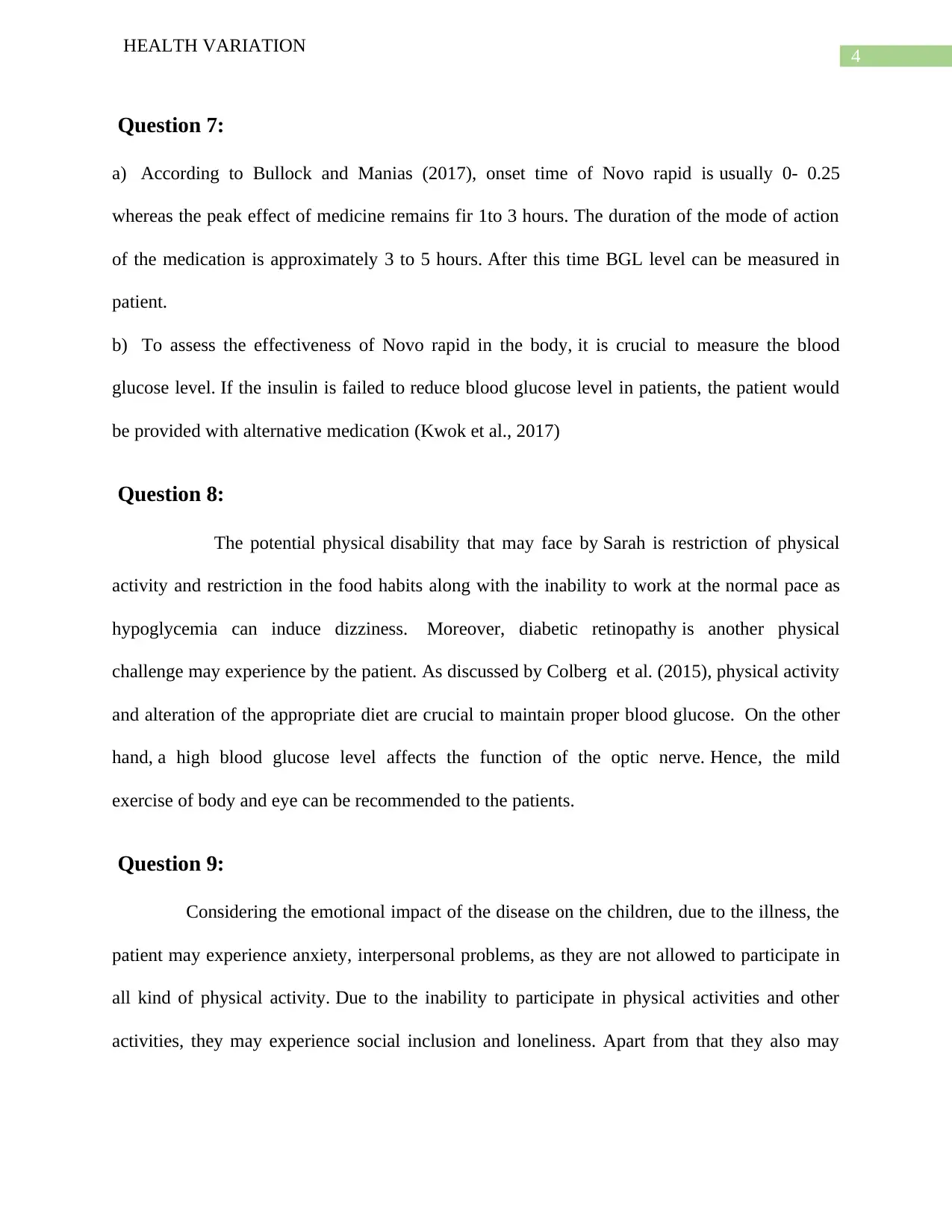
4
HEALTH VARIATION
Question 7:
a) According to Bullock and Manias (2017), onset time of Novo rapid is usually 0- 0.25
whereas the peak effect of medicine remains fir 1to 3 hours. The duration of the mode of action
of the medication is approximately 3 to 5 hours. After this time BGL level can be measured in
patient.
b) To assess the effectiveness of Novo rapid in the body, it is crucial to measure the blood
glucose level. If the insulin is failed to reduce blood glucose level in patients, the patient would
be provided with alternative medication (Kwok et al., 2017)
Question 8:
The potential physical disability that may face by Sarah is restriction of physical
activity and restriction in the food habits along with the inability to work at the normal pace as
hypoglycemia can induce dizziness. Moreover, diabetic retinopathy is another physical
challenge may experience by the patient. As discussed by Colberg et al. (2015), physical activity
and alteration of the appropriate diet are crucial to maintain proper blood glucose. On the other
hand, a high blood glucose level affects the function of the optic nerve. Hence, the mild
exercise of body and eye can be recommended to the patients.
Question 9:
Considering the emotional impact of the disease on the children, due to the illness, the
patient may experience anxiety, interpersonal problems, as they are not allowed to participate in
all kind of physical activity. Due to the inability to participate in physical activities and other
activities, they may experience social inclusion and loneliness. Apart from that they also may
HEALTH VARIATION
Question 7:
a) According to Bullock and Manias (2017), onset time of Novo rapid is usually 0- 0.25
whereas the peak effect of medicine remains fir 1to 3 hours. The duration of the mode of action
of the medication is approximately 3 to 5 hours. After this time BGL level can be measured in
patient.
b) To assess the effectiveness of Novo rapid in the body, it is crucial to measure the blood
glucose level. If the insulin is failed to reduce blood glucose level in patients, the patient would
be provided with alternative medication (Kwok et al., 2017)
Question 8:
The potential physical disability that may face by Sarah is restriction of physical
activity and restriction in the food habits along with the inability to work at the normal pace as
hypoglycemia can induce dizziness. Moreover, diabetic retinopathy is another physical
challenge may experience by the patient. As discussed by Colberg et al. (2015), physical activity
and alteration of the appropriate diet are crucial to maintain proper blood glucose. On the other
hand, a high blood glucose level affects the function of the optic nerve. Hence, the mild
exercise of body and eye can be recommended to the patients.
Question 9:
Considering the emotional impact of the disease on the children, due to the illness, the
patient may experience anxiety, interpersonal problems, as they are not allowed to participate in
all kind of physical activity. Due to the inability to participate in physical activities and other
activities, they may experience social inclusion and loneliness. Apart from that they also may
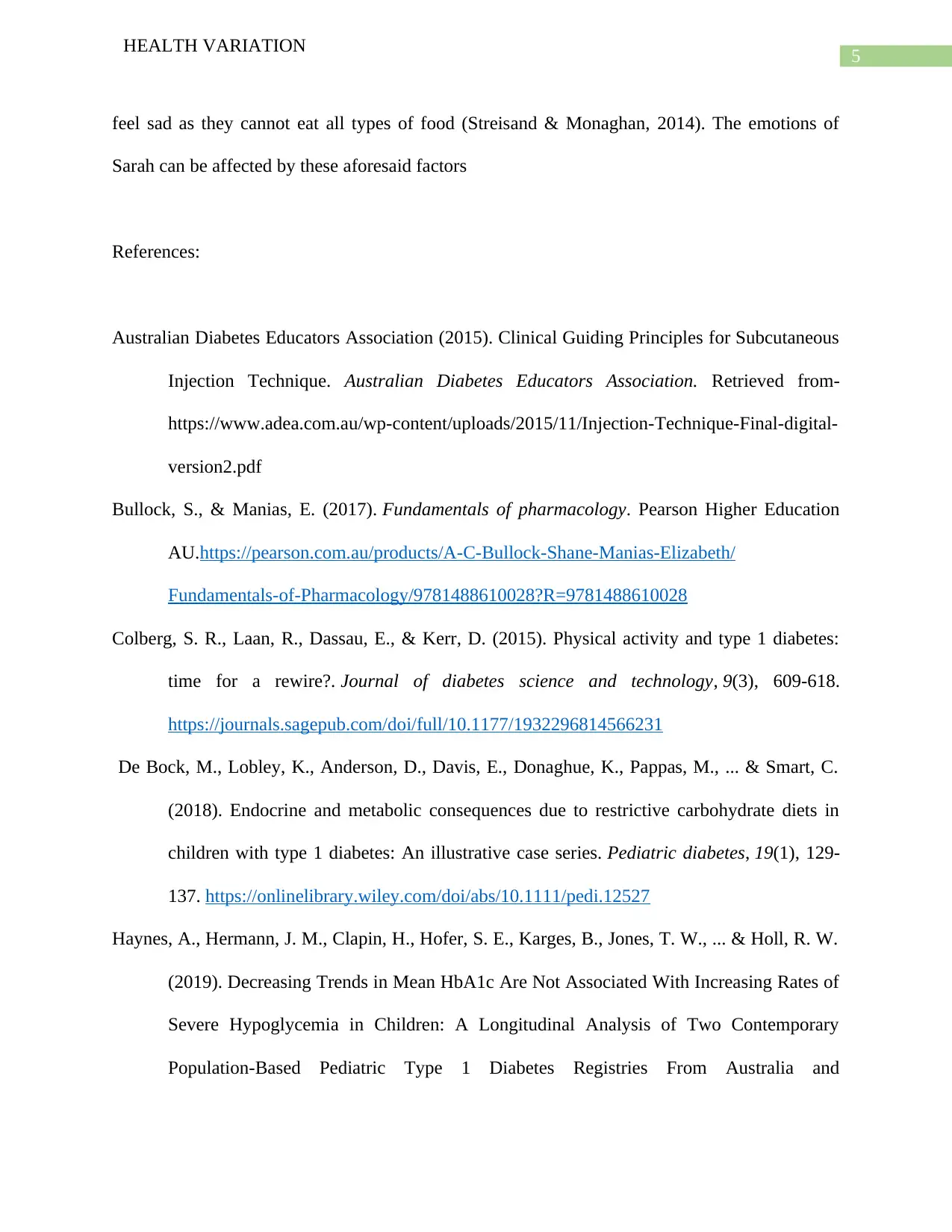
5
HEALTH VARIATION
feel sad as they cannot eat all types of food (Streisand & Monaghan, 2014). The emotions of
Sarah can be affected by these aforesaid factors
References:
Australian Diabetes Educators Association (2015). Clinical Guiding Principles for Subcutaneous
Injection Technique. Australian Diabetes Educators Association. Retrieved from-
https://www.adea.com.au/wp-content/uploads/2015/11/Injection-Technique-Final-digital-
version2.pdf
Bullock, S., & Manias, E. (2017). Fundamentals of pharmacology. Pearson Higher Education
AU.https://pearson.com.au/products/A-C-Bullock-Shane-Manias-Elizabeth/
Fundamentals-of-Pharmacology/9781488610028?R=9781488610028
Colberg, S. R., Laan, R., Dassau, E., & Kerr, D. (2015). Physical activity and type 1 diabetes:
time for a rewire?. Journal of diabetes science and technology, 9(3), 609-618.
https://journals.sagepub.com/doi/full/10.1177/1932296814566231
De Bock, M., Lobley, K., Anderson, D., Davis, E., Donaghue, K., Pappas, M., ... & Smart, C.
(2018). Endocrine and metabolic consequences due to restrictive carbohydrate diets in
children with type 1 diabetes: An illustrative case series. Pediatric diabetes, 19(1), 129-
137. https://onlinelibrary.wiley.com/doi/abs/10.1111/pedi.12527
Haynes, A., Hermann, J. M., Clapin, H., Hofer, S. E., Karges, B., Jones, T. W., ... & Holl, R. W.
(2019). Decreasing Trends in Mean HbA1c Are Not Associated With Increasing Rates of
Severe Hypoglycemia in Children: A Longitudinal Analysis of Two Contemporary
Population-Based Pediatric Type 1 Diabetes Registries From Australia and
HEALTH VARIATION
feel sad as they cannot eat all types of food (Streisand & Monaghan, 2014). The emotions of
Sarah can be affected by these aforesaid factors
References:
Australian Diabetes Educators Association (2015). Clinical Guiding Principles for Subcutaneous
Injection Technique. Australian Diabetes Educators Association. Retrieved from-
https://www.adea.com.au/wp-content/uploads/2015/11/Injection-Technique-Final-digital-
version2.pdf
Bullock, S., & Manias, E. (2017). Fundamentals of pharmacology. Pearson Higher Education
AU.https://pearson.com.au/products/A-C-Bullock-Shane-Manias-Elizabeth/
Fundamentals-of-Pharmacology/9781488610028?R=9781488610028
Colberg, S. R., Laan, R., Dassau, E., & Kerr, D. (2015). Physical activity and type 1 diabetes:
time for a rewire?. Journal of diabetes science and technology, 9(3), 609-618.
https://journals.sagepub.com/doi/full/10.1177/1932296814566231
De Bock, M., Lobley, K., Anderson, D., Davis, E., Donaghue, K., Pappas, M., ... & Smart, C.
(2018). Endocrine and metabolic consequences due to restrictive carbohydrate diets in
children with type 1 diabetes: An illustrative case series. Pediatric diabetes, 19(1), 129-
137. https://onlinelibrary.wiley.com/doi/abs/10.1111/pedi.12527
Haynes, A., Hermann, J. M., Clapin, H., Hofer, S. E., Karges, B., Jones, T. W., ... & Holl, R. W.
(2019). Decreasing Trends in Mean HbA1c Are Not Associated With Increasing Rates of
Severe Hypoglycemia in Children: A Longitudinal Analysis of Two Contemporary
Population-Based Pediatric Type 1 Diabetes Registries From Australia and
⊘ This is a preview!⊘
Do you want full access?
Subscribe today to unlock all pages.

Trusted by 1+ million students worldwide
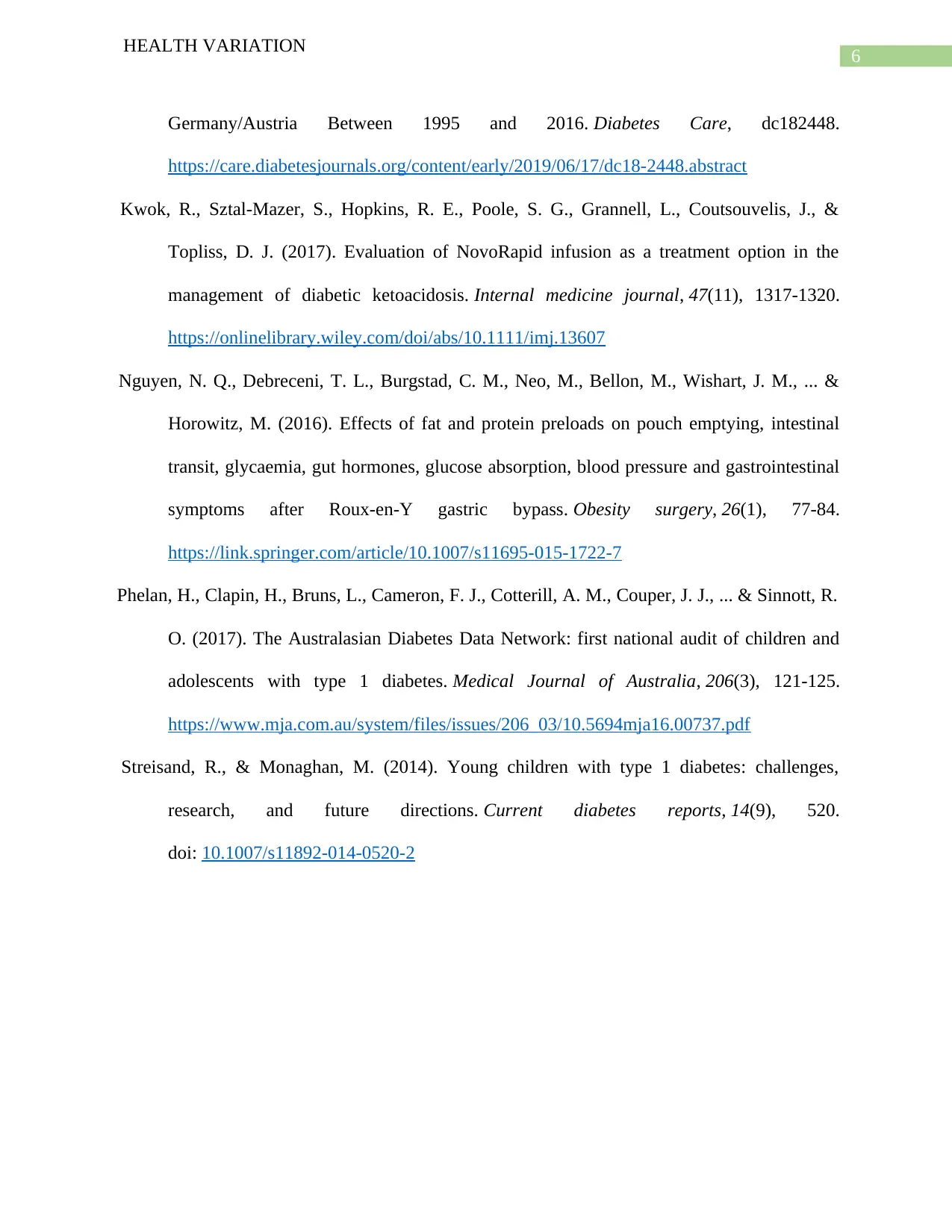
6
HEALTH VARIATION
Germany/Austria Between 1995 and 2016. Diabetes Care, dc182448.
https://care.diabetesjournals.org/content/early/2019/06/17/dc18-2448.abstract
Kwok, R., Sztal‐Mazer, S., Hopkins, R. E., Poole, S. G., Grannell, L., Coutsouvelis, J., &
Topliss, D. J. (2017). Evaluation of NovoRapid infusion as a treatment option in the
management of diabetic ketoacidosis. Internal medicine journal, 47(11), 1317-1320.
https://onlinelibrary.wiley.com/doi/abs/10.1111/imj.13607
Nguyen, N. Q., Debreceni, T. L., Burgstad, C. M., Neo, M., Bellon, M., Wishart, J. M., ... &
Horowitz, M. (2016). Effects of fat and protein preloads on pouch emptying, intestinal
transit, glycaemia, gut hormones, glucose absorption, blood pressure and gastrointestinal
symptoms after Roux-en-Y gastric bypass. Obesity surgery, 26(1), 77-84.
https://link.springer.com/article/10.1007/s11695-015-1722-7
Phelan, H., Clapin, H., Bruns, L., Cameron, F. J., Cotterill, A. M., Couper, J. J., ... & Sinnott, R.
O. (2017). The Australasian Diabetes Data Network: first national audit of children and
adolescents with type 1 diabetes. Medical Journal of Australia, 206(3), 121-125.
https://www.mja.com.au/system/files/issues/206_03/10.5694mja16.00737.pdf
Streisand, R., & Monaghan, M. (2014). Young children with type 1 diabetes: challenges,
research, and future directions. Current diabetes reports, 14(9), 520.
doi: 10.1007/s11892-014-0520-2
HEALTH VARIATION
Germany/Austria Between 1995 and 2016. Diabetes Care, dc182448.
https://care.diabetesjournals.org/content/early/2019/06/17/dc18-2448.abstract
Kwok, R., Sztal‐Mazer, S., Hopkins, R. E., Poole, S. G., Grannell, L., Coutsouvelis, J., &
Topliss, D. J. (2017). Evaluation of NovoRapid infusion as a treatment option in the
management of diabetic ketoacidosis. Internal medicine journal, 47(11), 1317-1320.
https://onlinelibrary.wiley.com/doi/abs/10.1111/imj.13607
Nguyen, N. Q., Debreceni, T. L., Burgstad, C. M., Neo, M., Bellon, M., Wishart, J. M., ... &
Horowitz, M. (2016). Effects of fat and protein preloads on pouch emptying, intestinal
transit, glycaemia, gut hormones, glucose absorption, blood pressure and gastrointestinal
symptoms after Roux-en-Y gastric bypass. Obesity surgery, 26(1), 77-84.
https://link.springer.com/article/10.1007/s11695-015-1722-7
Phelan, H., Clapin, H., Bruns, L., Cameron, F. J., Cotterill, A. M., Couper, J. J., ... & Sinnott, R.
O. (2017). The Australasian Diabetes Data Network: first national audit of children and
adolescents with type 1 diabetes. Medical Journal of Australia, 206(3), 121-125.
https://www.mja.com.au/system/files/issues/206_03/10.5694mja16.00737.pdf
Streisand, R., & Monaghan, M. (2014). Young children with type 1 diabetes: challenges,
research, and future directions. Current diabetes reports, 14(9), 520.
doi: 10.1007/s11892-014-0520-2
1 out of 7
Related Documents
Your All-in-One AI-Powered Toolkit for Academic Success.
+13062052269
info@desklib.com
Available 24*7 on WhatsApp / Email
![[object Object]](/_next/static/media/star-bottom.7253800d.svg)
Unlock your academic potential
Copyright © 2020–2025 A2Z Services. All Rights Reserved. Developed and managed by ZUCOL.





